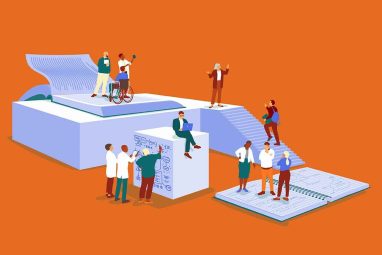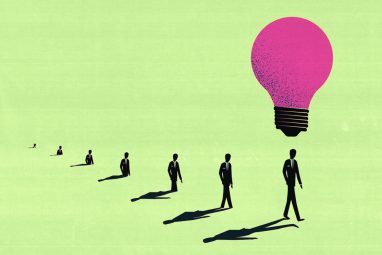The Invisible Barriers Holding Top Talent Back
Helping people recognize how hidden disadvantages affect team members can shift the way they think about fairness, new research shows.
News
- UAE introduces federal law to regulate child safety across digital platforms
- Middle East Has a Competitive Advantage as a Data Center Powerhouse, Says BCG
- CBD Becomes the UAE’s First Bank to Go Live Under the Open Finance Framework
- Will Halt Potential Rogue AI Systems, Says Microsoft AI Chief
- Google Bets Big on Data Infra With a $4.75B Deal in Intersect
- OpenAI Softens ChatGPT’s Tone While Scaling for an AI Showdown

Carolyn Geason-Beissel/MIT SMR
A senior manager at a call center in a large bank must promote one of two customer associates to shift manager. Both Martin and Seth have similar tenures and training. The major difference is in their productivity levels, determined by the index of calls made and customer satisfaction ratings. While both associates perform well above average, Martin’s productivity level is higher than Seth’s. Given Martin’s higher numbers, promoting him might seem clearly fairer.
If this is your intuition, it is based on the ideal of equity — that is, the idea that fairness is achieved when desirable outcomes such as pay, promotions, work assignments, and awards are aligned with meritorious contributions: Martin should get the promotion because he is more productive.
But would your intuition change if the decision involved Martin versus Nicole, a woman? On the surface, nothing has changed. Your intuition might say that only work contributions, not demographic characteristics like gender, are relevant to the fair distribution of rewards. For many, promoting Nicole over Martin just because she is a woman feels even less fair than promoting Seth over Martin.
In a forthcoming Academy of Management Journal paper, we explore how people evaluate these types of situations to arrive at fairness judgments and explain when and how they differ across people and situations.1 Our research found that when people take into account structural factors that influence others’ work, their ideas of fairness begin to shift. We propose that once people learn about barriers to women’s productivity in a specific work context, their intuitions change — and some may view promoting Nicole as fairer.
Equity and Equal Opportunity
The scenario above was inspired by Nicole Hallberg and Martin Schneider, two resume editing company employees. They ran an informal experiment in which they assumed each other’s identity, which Schneider tweeted about:
For two weeks, we switched names. I signed all client emails as Nicole. She signed as me. … Everything I asked or suggested was questioned. Clients I could do in my sleep were condescending. One asked if I was single. … Nicole had the most productive week of her career. … I wasn’t any better at the job than she was. I just had this invisible advantage.
That was the experience of just two people for two weeks, but the results were not surprising to us. Although it is not universally the case, in many work settings, women face invisible disadvantages. Work performed by women yields lower productivity levels or less-favorable ratings by managers and clients compared with identical work by their male colleagues who demonstrate the same effort and skill.2 For instance, in one study, hiring committee members rated an applicant as 1.3 times more competent and suggested a 14% higher starting salary when given an identical resume that was experimentally manipulated to include a man’s name rather than a woman’s.3 Other research shows that peers rate research abstracts by men as higher in scientific quality compared with similar abstracts by women, and that consumers or peers evaluate identical online courses and software code less favorably when they are produced by women rather than men.4
Our research explored whether learning about these barriers can change people’s intuitions about fairness. Many diversity, equity, and inclusion (DEI) discussions focus on equity as aligning outcomes with contributions, but our research highlights the ways that equal — or unequal — opportunity plays into equity. For example, if two people are rewarded based on the number of widgets produced, but one assembles more-complex widgets that require a variety of different skills, determining rewards based on widget counts alone is not necessarily equitable. Yet this is what many organizational reward systems do when determining how to reward women and other groups who are navigating often invisible disadvantages at work — their own version of producing more-complex widgets.
The Role of Beliefs About Work Success
Our research has uncovered two insights. First, people often assume that equal opportunity exists unless they have direct information to suggest otherwise. When participants in our studies learned about a promotion situation like the one described above involving Martin and Nicole, they rated promoting a woman rather than a man as 1.5 times less fair. However, when they learned that in this work setting, women, on average, have lower productivity because of invisible disadvantages due to gender discrimination, promoting either employee was judged as similarly fair.
This first insight is noteworthy. Most discussions of programs to support or favor women at work focus on the abstract or historical injustices women (and other disadvantaged groups) have faced. Such framing can make interventions seem detached from real-life situations; after all, it is not Martin’s fault that years of societal norms have created subtle and invisible barriers for women that men do not face.
We posit that resistance to affirmative action and other DEI programs stems from framing them around abstract or historical societal wrongs. Whether such a framing reflects reality or not, it tends to focus equity and fairness discussions on demographic categories.
Focusing instead on invisible disadvantages in a given context more clearly reveals task inequality and shows that even similar and clear criteria can mask differing work and effort. This focus shifts perceptions of fairness. Two people with similar performance levels may differ in effort and skill if one needs to overcome additional barriers; shouldn’t that difference factor into equity?
The second insight from our research is that, as noted above, average ratings of fairness diverge when people learn of women’s invisible disadvantages in specific contexts. Learning about why individuals do or do not succeed alters people’s interpretations of the relevance of invisible barriers.
People vary in how much they ascribe work success to individual factors — to internal, identifiable, and seemingly controllable factors, such as motivation, effort, and skill; or to structural external, identifiable, uncontrollable factors, such as social status, social networks, and systematic stereotyping.
Such beliefs are important because real-world data about barriers is often more ambiguous than the evidence from Hallberg and Schneider’s experiment. For example, at a certain university, professors who are women receive lower student ratings; does this reflect invisible barriers or an inherent difference in women’s capacity?5 Even if we agree that women face invisible barriers, it is possible that, in a particular woman’s case, such factors did not affect her productivity.
Our findings suggest that people’s beliefs about the structural causes of success function as an interpreting lens for such ambiguity. Across our studies, the more or less people ascribed success to structural factors, the more or less fair they thought promoting Nicole would be. People who held structural beliefs more strongly (one standard deviation above the mean) rated the fairness of promoting Nicole rather than Martin as 1.33 times fairer. People who held such structural beliefs less strongly (one standard deviation below the mean) rated the fairness of promoting Nicole rather than Martin as 1.20 times less fair.
Implications for Leaders
Our findings suggest four key takeaways for organizations and managers:
1. Don’t assume equality of opportunity. Equity rests on an assumption of equal opportunity, a factor that may vary in different work environments. Without information to the contrary, people assume that the playing field is level. Making this information salient for decision makers and observers may change their perceptions of the allocation of rewards like promotions, awards, and challenging assignments.
2. Consider multiple aspects of disparity. The gender equality movement has highlighted pay inequalities, using “equal pay for equal work” as a rallying cry. However, pay disparities often stem from unequal work opportunities and subtle, hard-to-account-for barriers. Thus, addressing disparities necessitates evidence of both.6
3. Get specific. Companies should move away from focusing on demographic categories and instead understand specific, unique barriers individuals face in localized contexts. This approach changes people’s intuitions. Moreover, some have argued that the Supreme Court opinion in the Students for Fair Admissions v. Harvard case may put organizational DEI initiatives at risk. The more specific approach we advocate for likely aligns with the Supreme Court opinion that mandates deemphasizing demographic characteristics and instead focusing on individualized experiences.
4. Openly discuss beliefs about the causes of success. Beliefs in structural causes of success shape people’s fairness judgments of reward allocations that take invisible barriers into account. Discussing these beliefs and their manifestations may help managers anticipate reactions to the allocation of rewards. Initial research indicates that meaningful interactions with those facing barriers can increase beliefs in the structural causes of success, making certain interventions (such as reverse mentoring) crucial in shaping fairness attitudes in an organization.7
Organizational psychologists Quinetta Roberson and William Scott argue that “fairness is … the mechanism through which the diversity-inclusion relationship works.”8 The term equity is frequently used in organizational DEI discussions, but the meaning, nature, and assumptions underlying equity are less frequently discussed. When it comes to gender equity, collecting, sharing, and widely discussing information about barriers confronting women and the advantages enjoyed by men can facilitate more nuanced and thoughtful dialogues around issues of fairness. Questioning the extent to which our organizations truly allow for equality of opportunity for all can open the door to redefining conceptions of fairness in the workplace and expanding opportunities for all employees.
References
1. A. Tedder-King and E.N. Sherf, “Fairness Judgments in the Context of Structural Sexism: The Role of Beliefs in Individual and Structural Causes of Success,” Academy of Management Journal, forthcoming.
2. C. Goldin and C. Rouse, “Orchestrating Impartiality: The Impact of ‘Blind’ Auditions on Female Musicians,” American Economic Review 90, no. 4 (September 2000): 715-741.
3. C.A. Moss-Racusin, J.F. Dovidio, V.L. Brescoll, et al., “Science Faculty’s Subtle Gender Biases Favor Male Students,” PNAS 109, no. 41 (Oct. 9, 2012): 16474-16479.
4. S. Knobloch-Westerwick, C.J. Glynn, and M. Huge, “The Matilda Effect in Science Communication: An Experiment on Gender Bias in Publication Quality Perceptions and Collaboration Interest,” Science Communication 35, no. 5 (October 2013): 603-625; A. Boring, K. Ottoboni, and P.B. Stark, “Student Evaluations of Teaching (Mostly) Do Not Measure Teaching Effectiveness,” ScienceOpen Research, vol. 0 (2016): 1-11; and J. Terrell, A. Kofink, J. Middleton, et al., “Gender Differences and Bias in Open Source: Pull Request Acceptance of Women Versus Men,” PeerJ Computer Science 3, no. 1 (May 1, 2017): e111.
5. K. Spoon, N. LaBerge, K.H. Wapman, et al., “Gender and Retention Patterns Among U.S. Faculty,” Science Advances 9, no. 42 (Oct. 20, 2023): 1-12.
6. M.T. Cardador, P.L. Hill, and A. Salles, “Unpacking the Status-Leveling Burden for Women in Male-Dominated Occupations,” Administrative Science Quarterly 67, no. 1 (March 2022): 237-284.
7. S. Chaudhuri, S. Park, and K.R. Johnson, “Engagement, Inclusion, Knowledge Sharing, and Talent Development: Is Reverse Mentoring a Panacea to All? Findings From Literature Review,” European Journal of Training and Development 46, no. 5/6 (2022): 468-483.
8. Q. Roberson and W. Scott, “Contributive Justice: An Invisible Barrier to Workplace Inclusion,” Journal of Management 50, no. 3 (March 2024): 877-897.








